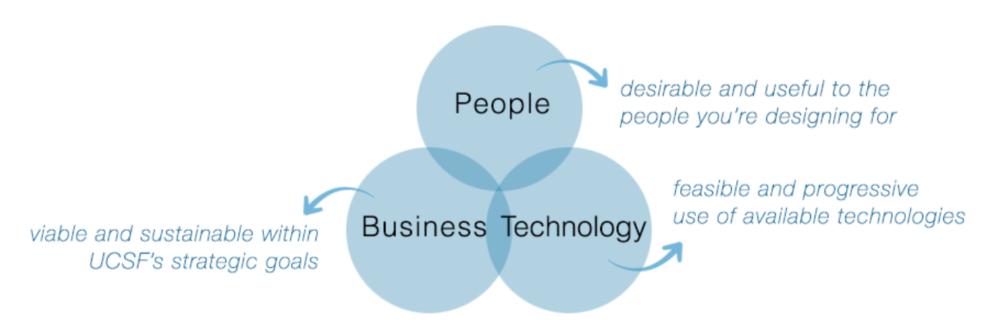By Traci Farrell. In a university setting, custom application development teams can hit roadblocks when project sponsors, designers, and developers have different definitions of success. To try to circumvent this problem, the Design and Discovery team in UCSF School of Medicine (SOM) Technology Services created a product toolkit to help teams successfully move a project into development without losing sight of the needs the project is addressing, the problem it’s trying to solve.
“My hope is teams will use the toolkit to create communal ownership of this information,” Design Strategy Lead Dana Ragouzeos said. “So it’s not just one person in a project meeting saying, ‘What’s the value here?’ but the whole team.”
SOM Tech created the toolkit to support the product owner or project sponsor and, maybe more importantly, as something the whole project team can work on collaboratively. The toolkit includes worksheets to help project teams package a shared product vision focused on value, align a product roadmap with human needs and business goals, and create and measure success metrics.
Project teams can use the toolkit to record:
- Vision statement and value definition
- What we know & what we don’t know
- Success metrics
- Product roadmap
- Minimum viable product (MVP) definition
- Usage scenarios and personas
Teams should use the documents to capture core information that is important to keep in mind throughout all phases of the project – who are the people they’re designing for, what are the scenarios, what are the goals, etc. SOM Tech usually spends four to six weeks before development begins exploring these questions, but has found this information doesn’t always stay in the foreground once development begins.
Ragouzeos hopes teams will print out the completed worksheets and display them during project meetings to help keep value top of mind during the decision-making process. “Product owners and teams often have to make decisions based on budget or time during the development process,” she said. “It can be easier to make decisions based on those concrete measures, but we want to balance that with value.”
The toolkit’s creation was a highly collaborative effort among SOM Tech’s business analysts, designers, and developers. Beth Berrean, deputy director of Design and Discovery, is careful to point out these product development best practices aren’t a new idea – every collaborative team needs tools to stay focused on its project’s goals.
“We can take these concepts and apply them in a university setting where product metrics are harder to come by,” she said. “UCSF isn’t the open market – it’s a unique academic environment with its own challenges, roadblocks, and opportunities.”
UC colleagues attending UCCSC 2018 at UC Davis this year have the opportunity to see the product toolkit in action. SOM Tech Business Analyst Ana Buenaventura and Designer Cynthia Milionis are leading the workshop, “Build Products that Really Matter,” on Tuesday, August 14. Workshop participants will be able to delve more deeply into value creation, roadmapping, and metrics to ensure a meaningful and useful product from inception to launch.
“This is an exciting time for the UX community,” Buenaventura said. “It’s a chance for product builders, designers, and managers to have an open and honest conversation about what really goes on and what we can do to build a product that people will love.”
 Traci Farrell is communications lead, School of Medicine Technology Services, UC San Francisco.
Traci Farrell is communications lead, School of Medicine Technology Services, UC San Francisco.







